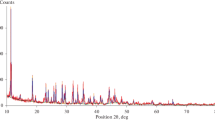Abstract
The dehydroxylation mechanisms of a biotite in the temperature range 300–800° C at controlled oxygen pressures were studied by infrared (IR) and Mössbauer spectroscopies. At low pressure, the lack of O2 delays the oxidation of Fe+2 and simultaneous loss of hydrogen but favours the loss of OH associated with octahedral vacancies in comparison with heat treatment in air.
Stoichiometrical considerations based on the facts that the octahedral cations are randomly distributed and all Fe+2 is oxidized lead to the conclusion that all the OH groups initially coordinated to Fe+2 must be lost during the oxidation process.
Similar content being viewed by others
References
Ericsson T, Wappling R (1976) Texture effects in 3/2-1/2 Mössbauer spectra. J Phys (Paris) 37:C6, 719–723
Farmer VC, Russell JD, McHardy WJ, Newman ACD, Ahlrichs JL, Rimsaite JYH (1971) Evidence of loss of protons and octahedral iron from oxidized biotites and vermiculites. Mineral Mag 38:121–137
Fernández M (1977) Estudio de los grupos OH en silicatos laminares. Ph. D. Thesis, Universidad Complutense, Madrid
Hodgson AA, Freeman AG, Taylor HFW (1965) The thermal decomposition of amosite. Mineral Mag 35:445–463
Hogg CS, Meads RE (1975) A Mössbauer study of thermal decomposition of biotites. Mineral Mag 40:79–88
Joswig W (1972) Neutronenbeugungsmessungen an einem 1M-phlogopite. Neues Jahrb Mineral Monatsh 1:1–11
Rausell-Colom JA, Sanz J, Fernández M, Serratosa JM (1979) Distribution of octahedral ions in phlogopites and biotites. In: Mortland MM, Farmer VC (eds) Development in sedimentology 27. Elsevier, Amsterdam, pp 27–36
Rousseaux JM, Gomez Laverde C, Natham Y, Rouxhet PG (1973) Correlation between the hydroxyl stretching bands and the chemical composition of trioctahedral micas. Proc. Intern Clay Conf Madrid 1972. Serratosa JM (ed) Division de Ciencias CSIC, Madrid, pp 89–98
Rouxhet PG, Gillard JL, Fripiat JJ (1972) Thermal decomposition of amosite, crocidolite and biotite. Mineral Mag 38:583–592
Sanz J (1976) Ordre-desordre dans la couche octaédrique des micas trioctaedriques. Etude par resonance magnétique nucléaire, infrarrouge et Mössbauer. Ph, D. Thesis, Université Catholique, Louvain
Sanz J, Stone WEE (1979) NMR study of micas. II. Distribution of Fe+2, F− and OH− in the octahedral sheet of phlogopites. Am Mineral 64:119–126
Serratosa JM, Bradley WF (1958) Determination of the orientation of OH bonds axes in layer silicates by infrared absorption. J Phys Chem 62:1164–1167
Vedder W, Wilkins RWT (1969) Dehydroxylation and rehydroxylation, oxidation and reduction of micas. Am Mineral 54:482–509
Wilkins RWT (1967) The hydroxyl stretching region of the biotite mica spectrum. Mineral Mag 36:325–333
Author information
Authors and Affiliations
Rights and permissions
About this article
Cite this article
Sanz, J., González-Carreño, T. & Gancedo, R. On dehydroxylation mechanisms of a biotite in vacuo and in oxygen. Phys Chem Minerals 9, 14–18 (1983). https://doi.org/10.1007/BF00309464
Received:
Issue Date:
DOI: https://doi.org/10.1007/BF00309464




